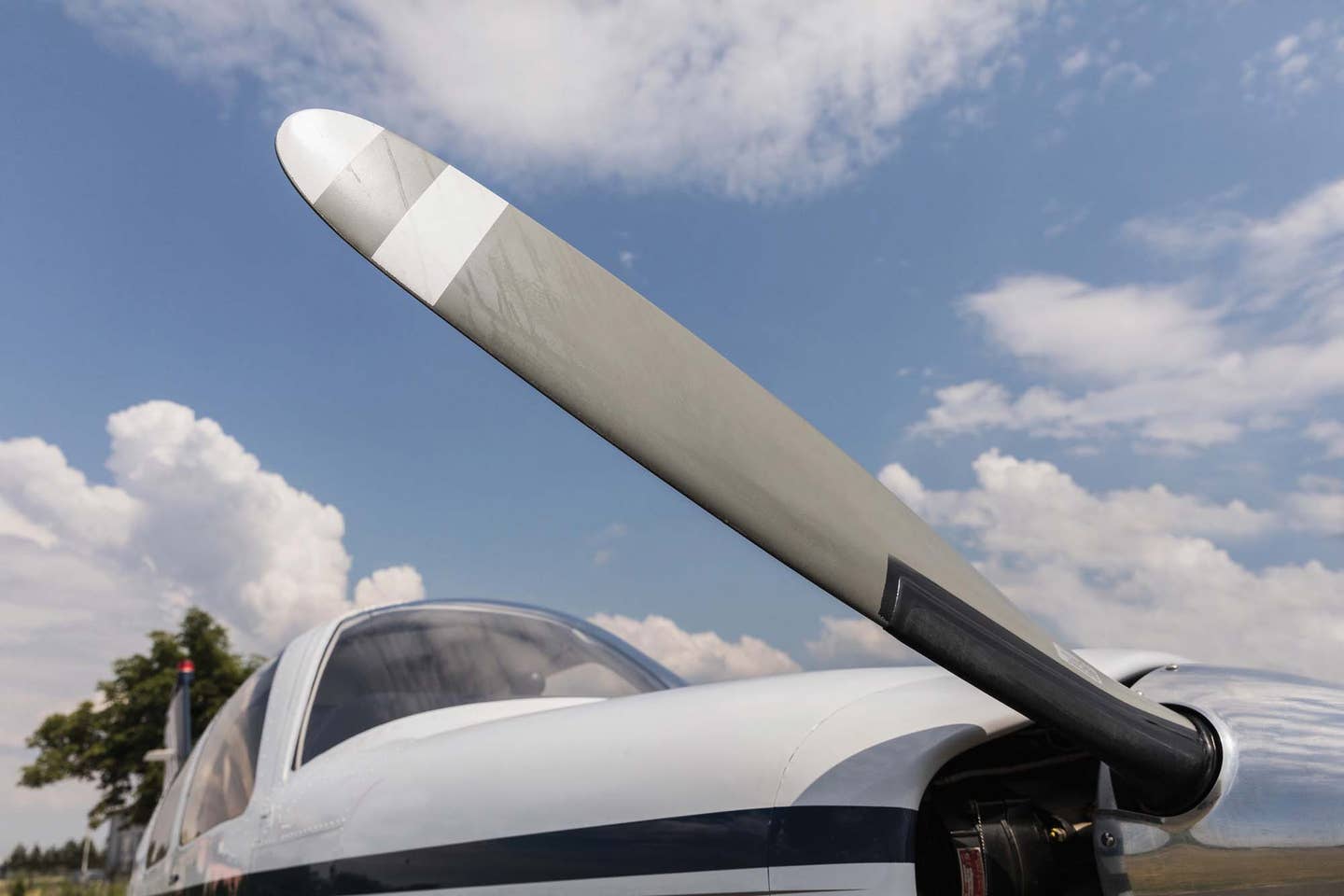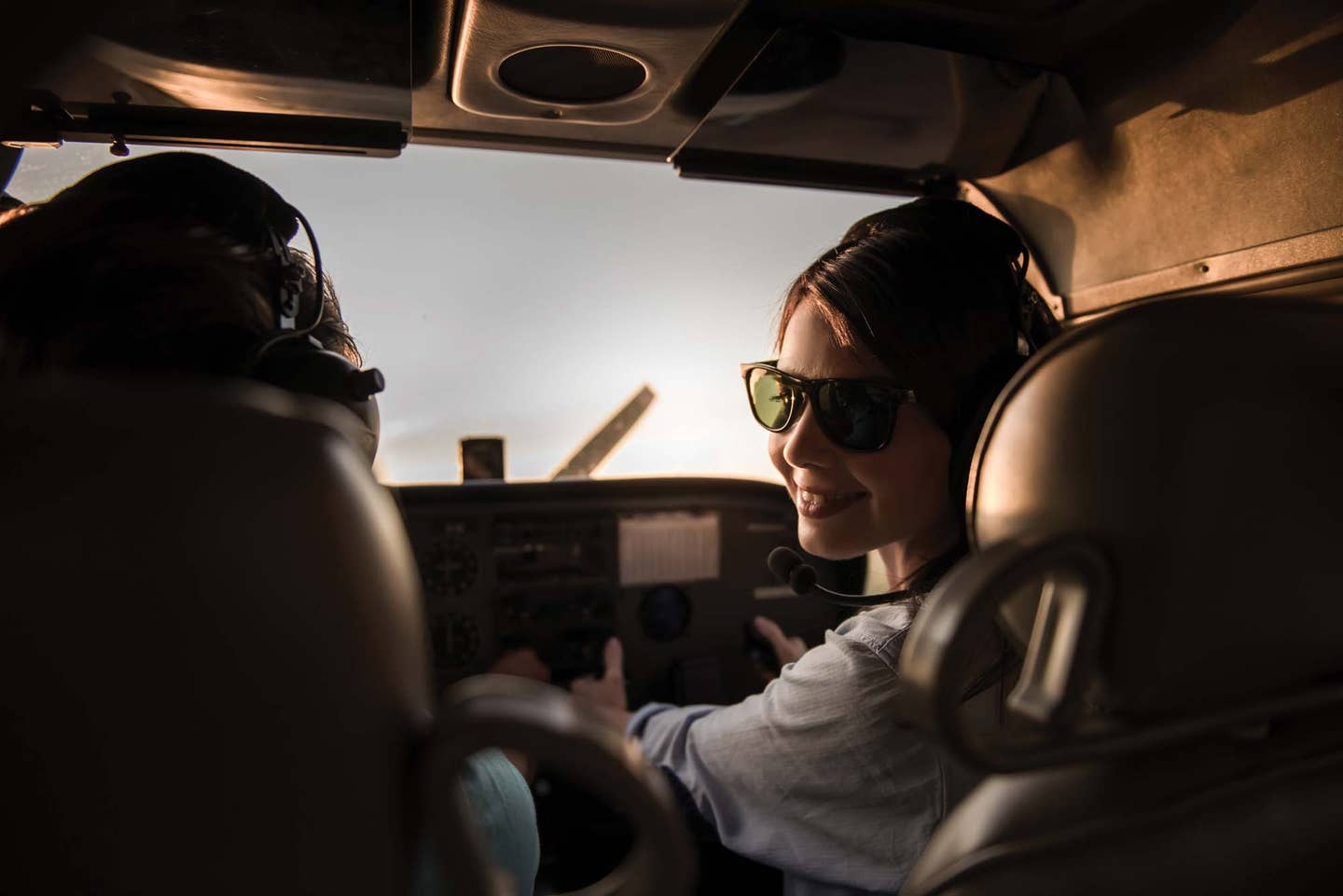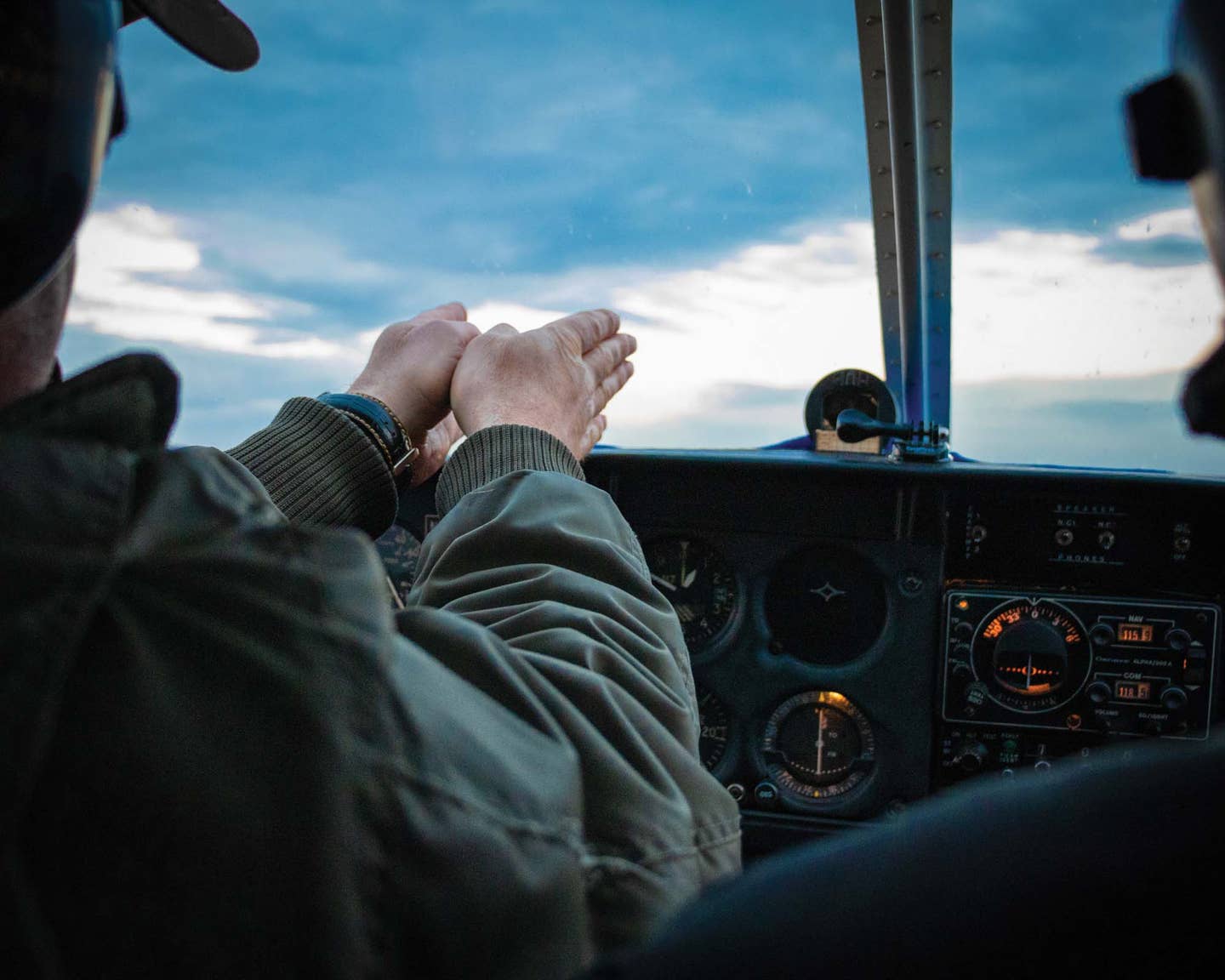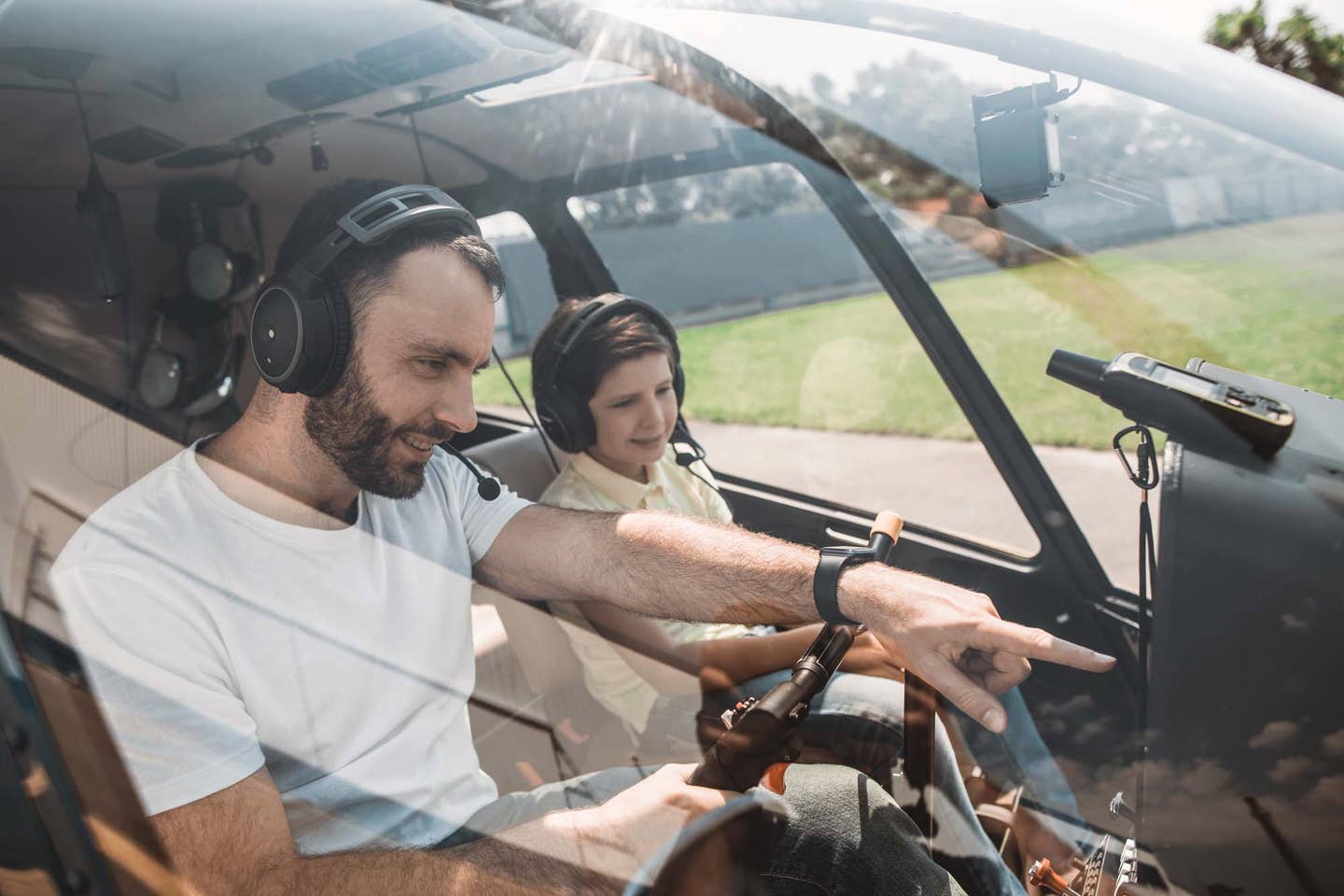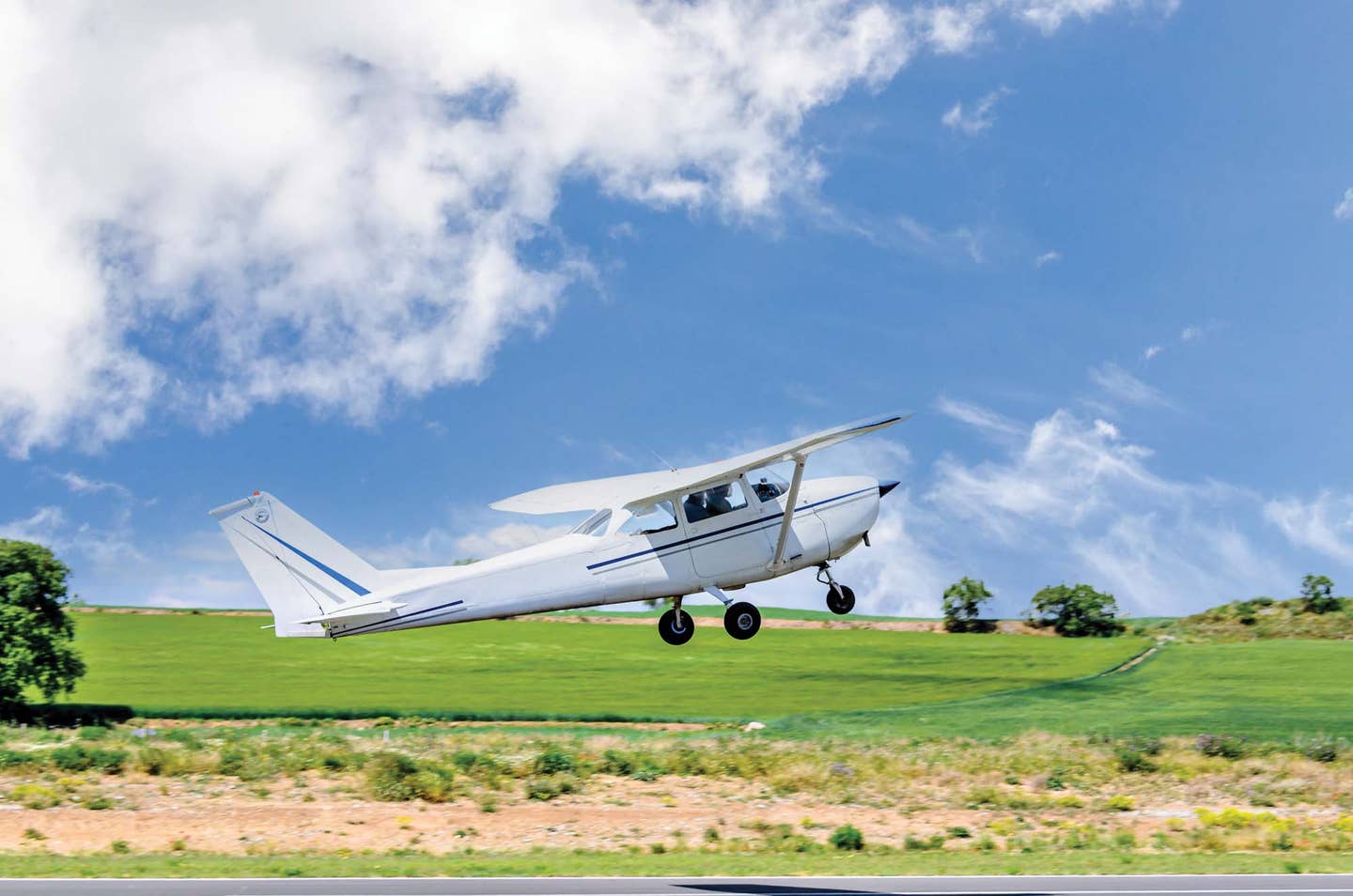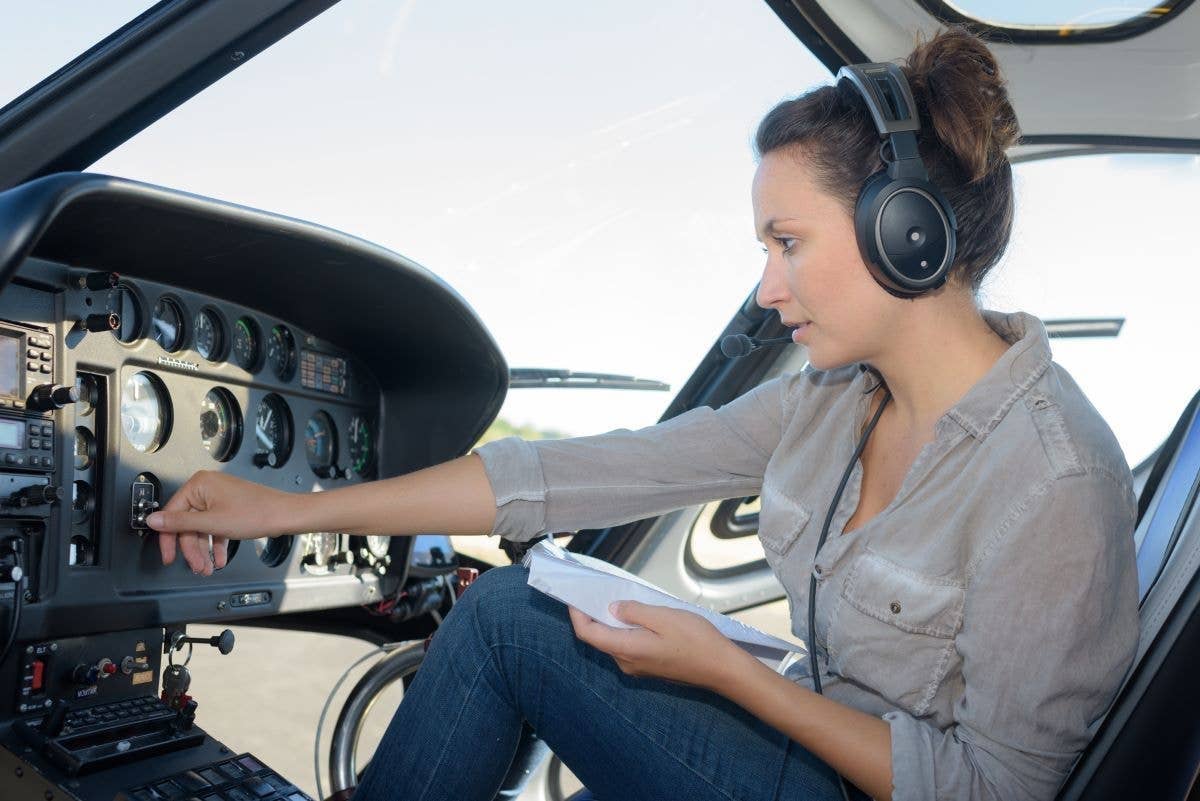Lost In The Clouds Over Idaho
The dramatic story of a visual flight rules pilot caught in thick clouds and ice between high mountain peaks and the air traffic controllers who helped him save his own life.
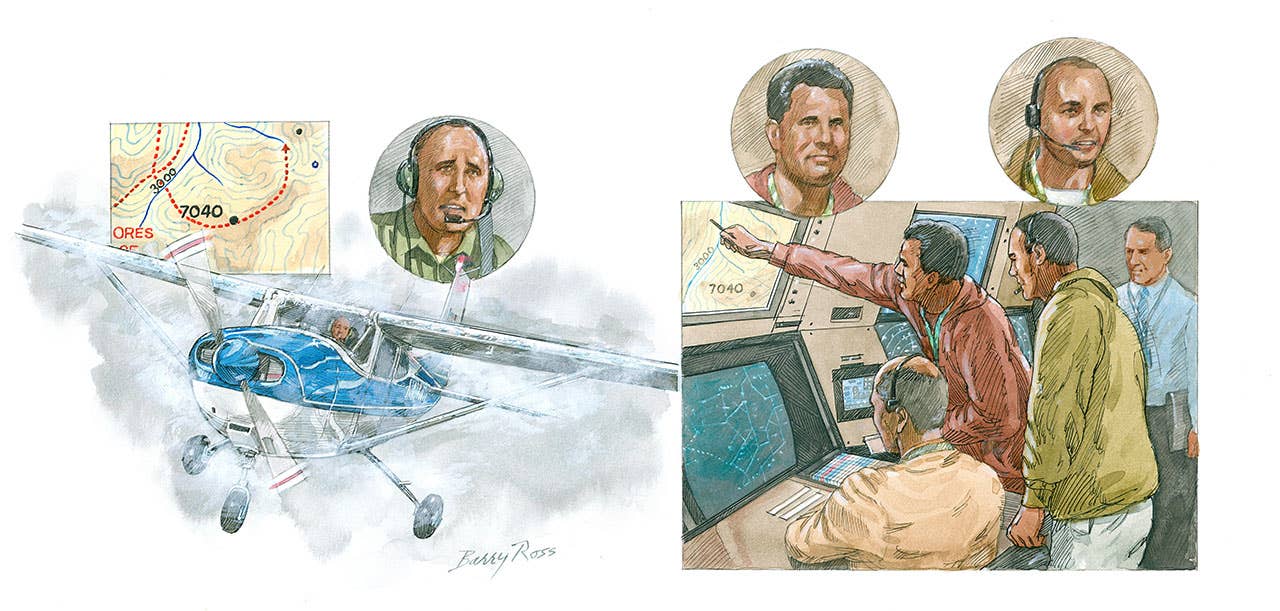
Illustration by Barry Ross
Tim Bendickson clambered into his rustic Cessna 182A. His worn jeans and chambray shirt meshed into N6122B's spartan interior. The 1957 Skylane had spent the past decade trundling through northern Idaho's splendor. Its teal paint mirrored the lush fields that unfurled amidst the surrounding valleys.
The Cessna needed a new alternator and had been flown to the Boundary County Airport three weeks earlier for repair. The Cabinet Mountains jutted skyward in the east; the Selkirks rose to the west. Canada was 30 miles north. The temperature hovered just above freezing that November afternoon in 2019. The gray clouds aloft foreshadowed winter's loom as the occluded sun edged toward the horizon.
Bendickson had spent the past 45 years logging the aged hemlock and red-fir evergreens that fleeced the mountains. His boots plodded over needle beds as he timbered the green giants. He often worked the brakes alone as he maneuvered his "skidders" and semi-trucks.
The forest's deep roots embodied Bendickson's own routines and comforts. He never flew N6122B far from home. The 64-year-old "pleasure-cruised" to neighboring Deer Park and Hackney from his home airport of Priest River. The Skylane was no modern wonder. Its instrument panel only contained a smattering of classic analog gauges. A rudimentary GPS was affixed to the rectangular-shaped control yoke.
The Cessna's engine turned over as Bendickson prepared for the short jaunt. The iPad flight-planning apps were unnecessary. The Pend Oreille River led the way home.
Bendickson had the requisite three hours of simulated "under-the-hood" instrument time during his private pilot training but had no interest in taking the Skylane into actual zero-visibility conditions, so he never pursued an instrument rating. In fact, N6122B had only flown about 20 hours per year since Bendickson earned his wings in 2009. He flew in fair skies, light winds, and when the mountains were clearly discernable. Stronger winds tumbling off the peaks could quickly usher clouds and precipitation into the captive valleys.
Bendickson had always gazed upward as aircraft passed overhead. His own flight training, though, entailed "hard learning." Instructor Darold Schultz's encouragement prevented Bendickson from quitting. Learning to fly takes dedication, practice and repetition. The challenge is what makes it great.
The Skylane eased onto Runway 20's centerline. The valley opened beyond the asphalt. Bendickson advanced the Cessna's throttle and quickly lifted into smooth skies. The clouds still hovered above; a few hours of daylight remained.
Four hundred miles away, the Seattle Air Route Traffic Control Center (ARTCC) thrummed with activity. Nestled in Seattle's south suburbs, its controllers handled aircraft flying throughout the Pacific Northwest. The sectors and radio frequencies encompassed most of Washington, Oregon and Idaho. Hushed dimness cloaked the control room as instructions shot skyward. Rapid and purposeful keyboard taps complemented the voices as the radar screen's data-blocks displayed aircraft speed, altitude and routing. The yellow and circular blips continuously slid across the blackness. The traffic never really stopped.
Air traffic controller Josh Fuller had just finished an eight-hour shift sequencing aircraft into Portland and Redmond, Oregon. He zipped his headset case and prepared to trade the Center's windowless rooms for Seattle's dampened air.
The Emerald City sharply contrasted with his native North Carolina. The summer's heat and towering thunderstorms shaped his private pilot training. Thermal air currents jostled the two-seat Cessna 152s around Franklin County Airport's traffic pattern.
The FAA had paused air traffic controller hiring in 2009 when Fuller graduated from Embry-Riddle Aeronautical University. He bided the time by becoming a 911 dispatcher. No emergency call or workday was ever the same. ATC and 911 dispatch entailed "good stress" that flying simply could not replicate.
Arriving at Seattle Center in 2018, Fuller quickly learned the Center's "B Area" sectors. Each shift taught valuable lessons as the 31-year-old's radio transmissions honed. Awareness and anticipation blossomed as his mind turned radar screens into multi-tiered pictures of aircraft position and trajectory. The scopes masked the Pacific Northwest's topography, but Fuller absorbed harried radio calls from pilots lamenting the weather that often gripped the region's mountains.
A controller's voice truly controls traffic. Instructions delivered in measured cadence denote confidence. Pilots need to trust ATC clearances. Fuller and his colleagues innately understood that radar blips moved quickly; there was no "pause" button in this game. Sometimes directives could not be repeated. The air traffic realm was measured in seconds versus minutes.
Supervisor Brian Kayner approached Fuller as he donned his oft-worn hoodie. Kayner worked in Area C, which controlled traffic in eastern Washington and northern Idaho. A private pilot was struggling to maintain aircraft control after inadvertently entering the clouds. He had lost all visual references. Perhaps a controller with flight experience could help guide the wayward airman to better weather.
Fuller mentioned his 180 hours of flight time---but also that he had not flown in years. He understood, though, that while other controllers had more experience, the perils of non-instrument-rated pilots losing sight of the outside world were absolute. Lives were quickly lost to panic and aircraft overcontrol as unbalanced inner-ear equilibriums led pilots astray. The mind played insidious tricks. Aircraft would be turning when the pilot felt that he was straight and level. The spatial disorientation could quickly worsen.
The frightened voice transmitting from the clouds signified time was short---an inverted hourglass with sand rushing to the bottom. "I'm at 6,000," he radioed. "I'm at 7,000 feet! I just about hit another mountain! I don't know where I'm at!"
Fuller palmed his headset and followed Kayner to Area C. He tried to envision the pilot's predicament and what could free him from the clouded prison---assuming that he was still alive.
His grip on the Skylane's yoke soon tightened. Clouds had formed below the Cessna's tires. White shrouds began covering the suddenly not-so-familiar mountain tops. Boundary Airport was nowhere to be seen.
* * *
Bendickson's departure from Boundary Airport had been uneventful. As he ascended to the southwest, another pilot transmitted over the airfield's frequency that they were terminating their pattern work. Weather seemed to be approaching. Bendickson gazed upward at the clouds. Boundary was about 10 miles behind him. Perhaps it was best to fly home another day. The Cessna banked and commenced its return.
His grip on the Skylane's yoke soon tightened. Clouds had formed below the Cessna's tires. White shrouds began covering the suddenly not-so-familiar mountain tops. Boundary Airport was nowhere to be seen. The seconds passed painfully as Bendickson's gaze swept the terrain. His breathing quickened as his bewilderment grew. The shapes of Idaho's mountains were akin to the backs of his hands working their slopes. Nothing outside the Skylane's cabin was recognizable.
The Cessna had likely already overflown Boundary Airport when it entered the clouds. Bendickson began making abrupt control inputs---hoping he could quickly return to clear air. His flight bag and windbreaker jostled against the Skylane's passenger door.
Bendickson shoved forward. The engine surged as the air rushing by the Cessna loudened. The cocooning whiteness was unabating as the altimeter started to unravel.
The descent eventually dropped the Cessna into visual conditions. Unfamiliar mountains filled N6122B's windshield. Bendickson yanked the yoke, and the Skylane's teal cowling pitched into the obscured horizon. The outcroppings silently passed somewhere below.
Climbing avoided terrain but tightened the clouds' stranglehold. The enveloping moisture whited out all ground traces. Bendickson could see the Skylane's propeller but only a uniform wall of nothingness beyond. Fair skies remained locked outside the opaque abyss.
Bendickson forced his eyes onto the Cessna's instruments. The indications had been convenient cross-checks to a normally beautiful outside world. Now the suction-driven gauges embodied salvation.
Adrenaline cultivated during Bendickson's logging career began resurfacing. His hefty timber trucks would skid uncontrollably down perilous mountain roads. Composure and poise enabled focus; instincts and quick thinking saved his life.
His instructor's guidance also reverberated. All pilots encounter difficult situations. Control what you can control. Stay calm. Fly the airplane.
Bendickson slowly dialed 123.9 MHz into the radio stack---afraid to tear his eyes away from the instruments. He thumbed the radio's push-to-talk switch that was Velcroed to the yoke. He depressed the button and called to whomever was listening. "Seattle Center, Cessna 6122B, I'm flying in the blind. I'm lost. Can you help me out?"
Fuller entered the Center's C area and plugged his headset into controller Dave Murphy's workstation. The setup was identical to his own, but the airspace was completely different. Controllers often spend entire careers working the same sections of sky. It can take a year to "recertify" in other areas. Fuller looking at Murphy's screen was arguably akin to a doctor performing surgery on another physician's patient---in an entirely different specialty.
Murphy briefed Fuller on the Cessna's plight. The pilot had encroached into Canadian airspace and was clearly struggling. The Cessna climbed from 9,700 to 10,700 feet in two minutes; heading swung from 211 to 102 degrees. The corkscrew patterns continued amidst the terrain embedded within the clouds.
Fuller stood behind the seated Murphy and stared at the screen. The devices were designed to handle traffic under ATC supervision versus flights where pilots determined their own courses and altitudes. The scopes did not depict terrain or mountain heights. Bland polygon shapes encased minimum vectoring altitudes. They resembled hollow puzzle pieces scattered over a black and featureless board. It was impossible to derive the mountains' location in relation to the Cessna's haphazard path.
Other Area C controllers were already working rescue plans. Michael Sellman, Byron Andrews and Ryan Jimenez separated traffic---essentially allowing Fuller sole possession of Cessna N6122B. The controllers searched for good weather where the Skylane could be vectored. Sellman liaised with a KC-135 flying into nearby Fairchild Air Force Base. He provided the fuel tanker's crew unrestricted clearance to locate favorable weather. Better conditions seemed to exist to the south.
The controllers shared uncomfortable and silent glances. The Cessna's pilot would likely have to fly nearly 100 miles solely on his instruments. The aircraft was fully fueled, but the gyrating turns could quickly transition into death spirals.
Murphy transmitted to the Cessna that a pilot was now on frequency. Fuller eyed the radar blip and tentatively hovered his thumb above his headset's transmit button. The Cessna's pilot was likely expecting a controller with robust flying experience versus someone whose last flight belonged to yesteryear.
Fuller's voice could only project confidence---a beacon that the pilot could follow. His insecurity would have to be masked by speaking slowly, clearly and without hesitation. Perhaps there were more qualified controllers, but at that moment, he was the lone option. Emergencies did not allow preference. His best effort would have to suffice.
Fuller let his even and composed voice fly. "N6122B, pilot speaking here. Are you currently in the weather?"
"I'm in the weather," Bendickson responded. "Yes, sir."
"N6122B, roger, just trust your attitude indicator. Keep your wings level for now. I want you to keep the climb going to get you above the terrain."
Bendickson remained fixated on the Cessna's instrument panel. The earlier descent and unnatural proximity to terrain revealed how quickly disaster could ensue. The voice filling his gray lightspeed headsets was nonjudgmental. The magnetic compass continued swinging, but it seemed that his pitch had steadied. "I just don't trust myself," he transmitted. "I'm not that good at flying on instruments."
"N6122B," Fuller responded, "I really need you to trust your attitude indicator. I need you to keep your wings level!and keep your altitude above the 10,000-foot mark!when you're in the weather like that, it's going to be hard to feel what the airplane is doing. That's why you need to trust those gauges."
Fuller began guiding the Cessna southbound. The radar returns only updated every 12 seconds, and each recalibration revealed wayward headings and course reversals. Fuller eventually began instructing Bendickson when to start and stop his turns versus issuing conventional heading assignments.
"I don't know what I'm doing," Bendickson radioed. "Just help me calm down, sir."
"N6122B, you're doing just fine. Again, trust your attitude indicator, keep your wings level!your heading is looking perfect right now. You're doing a great job."
While Fuller's voice coaxed Bendickson along, controller Brian Hach arrived at the Center. Hach's background arguably made him the most qualified to handle the emergency. He had 1,000 hours of flight time and was a certified flight instructor. He owned a Skylane for six years and understood the airplane's capabilities and nuances.
Hach's background arguably made him the most qualified to handle the emergency. He had 1,000 hours of flight time and was a certified flight instructor.
Upon learning what was unfolding in Area C, he joined the other controllers. Any notion of relieving Fuller, though, was immediately dismissed. Fuller stood motionless---a statue oblivious to surrounding activity. His radio transmissions were poised and collected. He had clearly become the pilot's lifeline. "Josh has a very magical way of working," Hach said. "He was the guy!What he had going on [with the pilot] was what mattered."
Wanting to be useful, Hach began trying to pinpoint the Cessna's exact location. He stood to Fuller's right and studied the En Route Information Display System (ERIDS). The electronic tool displayed conventional navigation "sectional" charts that specified terrain height and location. Hach tried to match the polygon shapes on Fuller's screen with the detailed map. He knew mountains were near the Cessna; the question was how close.
Bendickson temporarily broke into clear. The ground was still obscured, but he could once again reference visual cues as the Skylane cruised between cloud layers. He had been flying on instruments for nearly an hour.
The reprieve was short-lived. The undercast and overcast began converging once more. Bendickson had periodically warmed the Skylane's carburetor but had not heated the pitot tube. The L-shaped appendage protruded from the left wing and supplied ram-air pressure to the airspeed indicator. Electrical filaments within the pitot tube, when activated, kept its ducting above freezing. The heating helped ensure airspeed indicator accuracy when navigating cold and moisture-laden murk.
Clouds began growing larger in the Cessna's windscreen. "Seattle," Bendickson radioed, "should I fly above this cloud bank?"
Fuller preferred to keep the Cessna clear of the weather. Thinking that the pilot seemed relatively stable, and that improving conditions were close to the aircraft's position, he changed his mind. "I don't want you to go around those clouds," he transmitted. "I want to get you further southbound."
Bendickson soon reentered the leaden tomb. The sun started to fade; his panel began blending into the dusk. The Cessna had cockpit lighting, but just as he did not turn on the pitot heat, Bendickson could not free his eyes from the tunneled vision locked upon the instruments. The lighting's small control knob remained unturned.
"I'm still troubled by the answer I gave him," Fuller later said. "That's when the world began falling apart."
Ice began accruing on the Skylane approximately 10 minutes after Bendickson reentered the clouds. Brittle and milky-white coatings started rising from the Cessna's surfaces. Its lift began to be smothered. "I think I'm icing up on the wings here," Bendickson radioed. "I see ice on the struts."
"I want you to keep me updated on that," Fuller calmly responded. "Hopefully this heading is going to get you clear of the clouds here in just a couple of minutes."
N6122B began descending and drifting east. Fuller's directives remained difficult for Bendickson to follow. Each radar return showed lower altitudes---the blip sinking like a yellow stone into a black sea. "It's descending like crazy," Bendickson radioed.
Inch-thick ice ridged along the Skylane's leading edges. The unheated pitot tube eventually succumbed to the frozen glaze. Airspeed indications became erratic---then dropped to zero. Bendickson began to rely on the slipstream to estimate the Skylane's velocity. He had no idea what speed would trigger an aerodynamic stall and cause the Skylane to stop flying. The cold air rushing by the cockpit and control feel were his only indicators. Such perception and intuition would arguably challenge even the most skilled and experienced pilots.
As Bendickson struggled through the clouds, controller Hach continued crosschecking the radar scope against the sectional chart. The two platforms began aligning as he started deriving the Cessna's position relative to the mountains.
The Cessna continued meandering east and losing altitude. The scope's data-block indicated 8,800---then 8,100, and 7,900 appeared on subsequent updates.
Hach's eyes darted between the screens. The sectional depicted the expansive Lake Pend Oreille. Brown and uneven shades colored the terrain to the east. The highest peak was bolded with an altitude of 7,100. Hach's scan lingered as he forced his eyes back to the radar screen---now realizing what the aircraft blip would confirm. The Cessna was headed directly into the mountains. The altitude readout dropped further to 7,300 as the ice-laden Cessna continued its downward slide.
"You've got to turn him, Josh," Hach remembered saying.
"Which way?" Fuller replied. His eyes remained locked on the radar screen.
"Left!"
Fuller knew the Cessna would either stall or careen into the rocks unless it reversed course and gained altitude. The pilot could not see beyond the encased whiteness, but Fuller understood that his voice might be the last thing he ever heard. He had taken 911 calls when panicked callers tried to administer CPR to dying loved ones. The voices became strained and desperate as life slipped away.
The Cessna's radar blip arguably embodied the pilot's heartbeat as the yellow dot rose and fell across the screen. Forthcoming radar updates may have simply shown blackness---the Cessna's blip flatlined amidst strewn wreckage and the mountain's silent and uncompromising shale.
Fuller's next instructions could have ensured the pilot's demise. If he told the pilot to climb, the ice-heavy Skylane could stall. Its lift could also cease if it banked too steeply. There was no good option, but if he said nothing, the outcome was absolute.
"N[61]22B," he transmitted, "if you can climb, I need you to climb. The highest obstacle in your area is going to be around 7,100, so I need you to hold your altitude."
"I'm losing altitude," Bendickson answered. "It's a little bit out of whack here."
"! N[61]22B, most importantly right now, I need a heading towards the west. Any heading that's towards the west."
The Cessna's blip continued edging eastward. Its altitude dropped to 7,000 feet.
"N[61]22B!okay, I want you to make sure your [fuel] mixture is full rich. I want to make sure your throttle is 100 percent."
"Yes, sir."
The Cessna's radar blip began sliding northward, but its altitude flashed lower.
"N[61]22B," Fuller slowly instructed, "I need you to start a left-hand turn, and I want you to point west!we'll start with that. I want you to focus on keeping your attitude indicator level with the horizon!"
Bendickson did not respond. The seconds passed.
"N6122B, can you hear me?" Hach, Sellman and the controllers hesitantly glanced at each other. Perhaps the pilot was simply too low for radio contact. As Fuller continued staring at the screen, the surrounding solemn expressions began reflecting the growing likelihood that the Cessna's pilot was gone. "When I saw the altitudes [drop] and then no responses [from the pilot]," Hach remembered, "that's when I'm thinking we're done."
Bendickson still could not see through the clouds as he tried to maintain altitude and turn west. The Skylane had no equipment to detect terrain. Its pistons fired at full power as ice stubbornly clung to its surfaces. The airspeed indicator remained pegged at zero.
Bendickson eyed the attitude indicator and continued following the controller's voice. He had resigned himself to putting his complete trust into the guidance emanating through his headsets. He heard some other aircraft on the frequency, but the controller who kept using the Skylane's callsign, the one who identified himself as a pilot, seemed to be dedicated just to him. The reassuring voice was consistently in his ears---a protective lifeline that was his lone chance of survival.
Fuller's radar scope continued its 12-second updates. With each refresh, the Cessna's blip still shone. Altitude appeared steady.
Hach glanced at the sectional and frowned. Mountains still lined the Skylane's projected course like unbroken waves.
"N6122B," Fuller transmitted, "It looks like you're still on a northbound heading. That's back into the worse weather and into higher terrain. If we can make a left-hand turn, a very gradual left-hand turn, I don't want you to do a fast one, but keep your attitude indicator level with the horizon."
"Yes, sir. I thought I was going right!Okay, here I come."
"N[61]22B, you're doing a great job. Again, just a very gradual left-hand turn."
If the Cessna had suddenly popped into clear air during those moments, Bendickson might have again instinctively hauled back on the yoke---this time putting the ice-carrying Skylane into a non-recoverable stall. The evergreen trees may have hurtled by at incomprehensible speed. Individual branches may have been visible, their needles nearly prickling the Cessna's fixed landing gear.
It is estimated that the Cessna cleared the peaks by as little as 90 feet. While its altitude subsequently dipped further, Bendickson's lack of heading control somehow allowed him to slalom between the mountains blindly. He laterally missed the terrain by a half-mile. "If somebody told me this happened," Hach remembered, "I wouldn't believe it."
Fuller stared at the screen. The scopes did not depict terrain or mountain heights. It was impossible to derive the mountains' location in relation to the Cessna's haphazard path.
The Cessna's radar blip began creeping west as Bendickson responded to the instructions carried by Fuller's voice. Lake Pend Oreille's calm waters eventually lulled somewhere below as the foreboding mountains distanced behind the Skylane's tail.
Controller Mike Sellman and his Area-C teammates had determined that nearby Coeur d'Alene Airport offered favorable weather. The KC-135 that Sellman had coordinated with had located good conditions and remained on frequency to report updates.
Approximately 90 minutes after Bendickson first entered clouds, a euphoric radio transmission was received. "Oh, I can see land!"
"N[61]22B, perfect," Fuller acknowledged. "That's where I want you to go."
As the clouds abated and conditions improved around the Skylane, Bendickson transmitted again. "When I get on the ground, I want to give you a big kiss, sir."
Fuller chuckled through his microphone. "I'd love that."
As the Cessna neared Coeur d'Alene, Fuller continued monitoring the Cessna's radar blip.
"N[6122B, just checking in on you. How are you doing?"
"I'm fine now, sir. I can see land! wow, what a ride. Thank you so much!"
"N[61]22B, no problem."
Fuller soon handed Bendickson off to Spokane Approach Control as the Cessna edged further west. The ordeal had lasted nearly two hours. Fuller had been standing and talking to the Cessna nearly all that time.
Bendickson acknowledged the frequency change. It was the customary goodbye between pilot and controller as aircraft crossed airspace boundaries, even though it had been no ordinary interchange. Fuller keyed his microphone as if to reply, but no words came. The channel nevertheless remained open. Applause sounded throughout the control room until Fuller let go---his voice finally at rest.
Cessna N6122B touched down on Coeur D'Alene's Runway 6 shortly thereafter. Ice still clung to the Cessna's airframe under a fully dark night sky. Bendickson pulled the Cessna's fuel mixture to idle cutoff, and its faithful engine grew silent in well-deserved repose.
He had already decided to drive the seven hours to Seattle soon to thank the controllers who saved his life personally. In the interim, while he sat lost in his emotions and thoughts, other aircraft were flying overhead and throughout the pacific northwest. N6122B had finally left Seattle Center's scopes, but countless other radar blips were still crossing its radar screens. The facility's controllers would be dutifully watching---their voices guiding other pilots home.
Have you had a close call or a cool aviation experience that left a lasting impression? Share your story in our Lessons Learned About Flying Essay Contest today.
Read "Used Cessna 182 Skylanes" to learn more about the airplane in the incident.
Read "Mountains Demand Pilots' Respect" to enjoy another pilot's Lessons Learned story.

Subscribe to Our Newsletter
Get the latest Plane & Pilot Magazine stories delivered directly to your inbox

